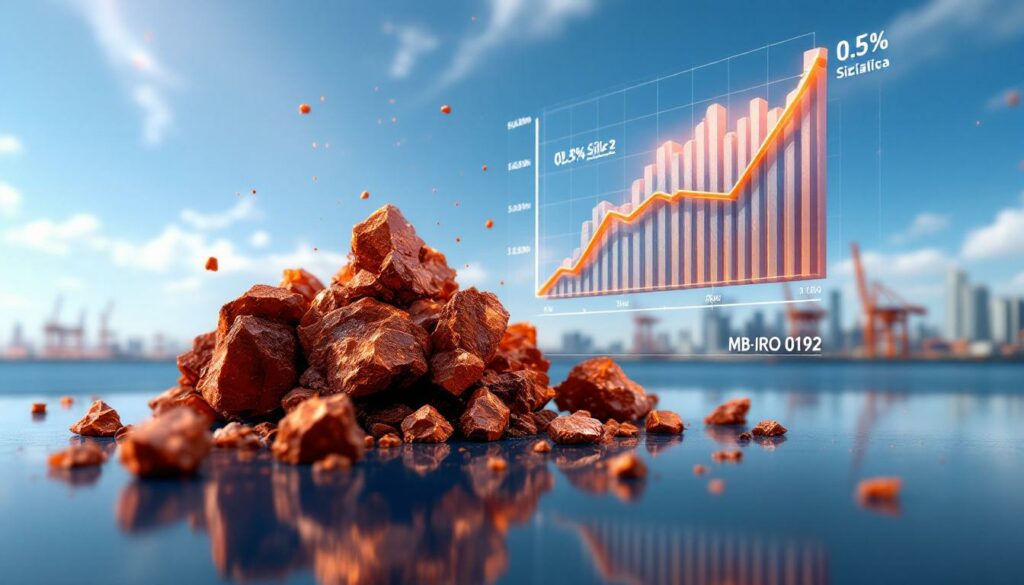Understanding the High-Grade Iron Ore 0.5% Si VIU Index: A Comprehensive Guide
The launch of high-grade iron ore 0.5% Si VIU index represents a significant milestone in the evolution of iron ore pricing mechanisms. This specialized pricing tool addresses the growing market need for more precise valuation of premium iron ore products with varying silica content, providing traders, producers, and consumers with enhanced transparency and pricing accuracy. Furthermore, understanding current iron ore price trends is essential for market participants looking to leverage this new index effectively.
What Is the New High-Grade Iron Ore Silica VIU Index?
The Purpose and Development of the New Index
The high-grade iron ore 0.5% Si VIU (Value-In-Use) index, officially coded as MB-IRO-0192, was developed to provide market participants with a precise reference point for valuing high-grade iron ore with varying silica content. Launching on Friday, August 1, 2025, this specialized index addresses a critical gap in the market by quantifying how silica levels impact the value of premium iron ore products.
Unlike traditional fixed-discount models, this index employs a market-based approach to price adjustment, reflecting real-world trading conditions and value perceptions. The index specifically targets high-grade iron ore within the 63-70% Fe range, addressing the commercial reality that silica content significantly impacts processing costs and final steel quality. For many industry analysts, this development comes at a crucial time as iron ore price decline scenarios are being closely monitored.
Technical Specifications and Methodology
The index utilizes sophisticated regression analysis that incorporates both pricing data and chemical specifications of high-grade iron ore products. This analytical approach enables the index to accurately reflect how silica content influences the market value of high-grade iron ore across an optimized range of 1-8.5% silica content.
As stated in Fastmarkets' pricing notice from July 31, 2025:
"This market-based VIU approach incorporates both pricing data and associated chemical specifications to reflect the relative impact of silica content on high-grade iron ore values."
The methodology employs rigorous statistical techniques to isolate the specific value impact of silica while controlling for other variables that might influence pricing. This produces a reliable, data-driven index that closely mirrors actual market valuation practices.
Why Is This Index Important for the Iron Ore Market?
Market Transition Support
The introduction of this index coincides with significant changes in established market specifications, particularly the increase in silica base specifications in the MB-IRO-0009 iron ore 65% Fe Brazil-origin fines index—from 2.2% to 2.7%. This adjustment reflects evolving industry standards and market preferences.
The new silica VIU index serves as a critical transitional tool, helping market participants navigate these updated specifications while maintaining pricing consistency and transparency. According to Fastmarkets' July 31, 2025 pricing notice, "This new index is designed to support the market's transition and provide participants with a reference point for deriving trade values under the updated IOCJ specification."
This transitional support is particularly valuable for long-term contracts that may have been negotiated under previous specifications but need to accommodate the new market reality.
Enhanced Pricing Precision
The silica VIU approach provides a significantly more nuanced valuation mechanism compared to traditional fixed-discount models. By incorporating actual market data and chemical compositions, the index delivers a more accurate reflection of how varying silica levels impact high-grade iron ore values in real-world trading scenarios.
This enhanced precision benefits multiple stakeholders:
- Producers can better understand and capture the value premium of their low-silica products
- Traders gain a more objective basis for negotiating price adjustments
- Consumers (steelmakers) can more accurately assess the true economic value of different iron ore products
- Financial institutions receive a more reliable benchmark for derivatives and financial products
In addition, recent price forecast insights suggest that precise pricing mechanisms will become increasingly important in the volatile market environment expected in 2025.
How Does the Index Calculate Value Adjustments?
The Value-In-Use (VIU) Concept
The Value-In-Use concept is fundamental to understanding this index. VIU quantifies how specific chemical properties affect the economic value of iron ore in steelmaking processes. In the case of silica content, this impact is substantial and multifaceted:
- Flux consumption: Higher silica requires more limestone or other fluxes to maintain proper slag chemistry
- Energy requirements: Additional energy is needed to melt and process the extra slag volume
- Productivity impact: Higher silica can reduce blast furnace throughput and efficiency
- Environmental considerations: More slag generation increases waste management challenges
The VIU approach translates these technical impacts into precise economic terms, providing a market-based mechanism for valuing quality differentials.
Regression Analysis Methodology
The index employs sophisticated regression analysis that processes multiple data points to isolate the specific value impact of silica content. As described in Fastmarkets' pricing notice, the methodology:
- Processes price inputs from actual market transactions
- Incorporates detailed chemical composition data
- Establishes correlations between silica content and market value
- Generates adjustment factors that reflect real market conditions
This statistical approach ensures that the index captures genuine market perceptions of value rather than theoretical or arbitrary adjustments. The methodology includes robust outlier screening and applies a quantity-weighted model to ensure data integrity and representativeness.
What Are the Technical Specifications of the New Index?
Index Identification and Parameters
The high-grade iron ore 0.5% Si VIU index has clearly defined specifications that ensure consistency and reliability:
| Parameter | Specification |
|---|---|
| Index Code | MB-IRO-0192 |
| Official Name | High-grade iron ore, 0.5% Si VIU, CFR Qingdao |
| Unit | USD per tonne |
| Publication Schedule | Daily at 6:30 PM Singapore time |
| Delivery Terms | CFR Qingdao, normalized for any Chinese mainland sea port |
| Timing | Within two weeks |
| Payment Terms | Payment at sight, with other terms normalized to base |
| Origin | All origins accepted |
| Fe Range | 63-70% |
| Silica Range | 1-8.5% |
These detailed specifications ensure that market participants have complete clarity regarding what the index represents and how it can be applied to their specific trading scenarios.
Data Quality and Methodology Safeguards
Maintaining the integrity and reliability of the index is paramount. Fastmarkets employs several safeguards to ensure the index remains representative and free from manipulation:
- Outlier screening: Statistical techniques identify and exclude anomalous data points
- Quantity-weighted modeling: Larger transactions receive proportionally greater influence
- Independence: Fastmarkets has no financial interest in the level or direction of the index
- Methodology transparency: Complete documentation is publicly available
As stated in Fastmarkets' pricing notice: "Fastmarkets' index methodology screens outliers and applies a quantity-weighted model," ensuring the index maintains its position as one of the most reliable in the industry.
How Will This Index Impact Iron Ore Trading Practices?
Benefits for Market Participants
The introduction of this specialized index offers several advantages for traders, producers, and consumers in the iron ore market:
- More precise valuation: The index provides a data-driven mechanism for valuing high-grade iron ore with varying silica content
- Enhanced transparency: A standardized approach to quality adjustments reduces negotiation friction
- Improved risk management: Better pricing precision enables more effective hedging strategies
- Contract flexibility: The index supports both fixed-price and floating-price contract structures
- Smoother specification transitions: Market participants can navigate changing quality standards with minimal disruption
These benefits collectively contribute to a more efficient, transparent, and well-functioning iron ore market. However, the market impact will also depend on miners' demand insights and how producers respond to these new pricing mechanisms.
Integration with Existing Price Benchmarks
The new index complements Fastmarkets' existing suite of iron ore price assessments, providing a more comprehensive pricing ecosystem. According to Fastmarkets' pricing notice, "These prices will be part of the Fastmarkets steelmaking raw materials package," offering subscribers integrated access to related price data.
This integration enables market participants to:
- Compare relative value across different quality segments
- Develop more sophisticated trading and hedging strategies
- Gain deeper insights into market premiums and discounts
- Create customized pricing formulas that precisely match their quality requirements
What Market Trends Led to the Development of This Index?
Evolving Quality Specifications
The iron ore market has been experiencing a gradual shift in quality specifications, with particular attention to impurity levels like silica. This evolution reflects changing requirements in steelmaking processes, especially as environmental regulations and efficiency demands increase.
The most immediate catalyst for the new index was the "recent proposal to amend the specifications of the MB-IRO-0009 iron ore 65% Fe Brazil-origin fines, cfr Qingdao index—specifically, the increase in the silica base specification from 2.2% to 2.7%," as mentioned in Fastmarkets' pricing notice.
This specification change highlights the dynamic nature of iron ore quality standards and the need for pricing mechanisms that can adapt to these evolving requirements.
Growing Premium for Higher-Quality Products
The market has increasingly recognized the value differential between standard and high-grade iron ore products. This trend has been driven by:
- Environmental regulations: Stricter emissions controls favor higher-grade inputs
- Productivity focus: Steelmakers seek to maximize furnace efficiency
- Quality requirements: More demanding end-use applications require better steel properties
- Energy cost considerations: Higher-grade ore can reduce energy consumption
These factors have created demand for more sophisticated pricing mechanisms that can accurately capture quality premiums and discounts, particularly for silica content which significantly impacts processing costs and final steel quality. The economic implications of these shifts are particularly pronounced in regions with significant resources sector impact from iron ore mining.
How Can Market Participants Engage with the New Index?
Data Submission Opportunities
Market participants can contribute to the index's accuracy and representativeness by becoming data submitters. According to Fastmarkets' pricing notice, interested parties can contact "Norman Fong by email at: pricing@fastmarkets.com" with the subject line "FAO: Adele Pan/ Paul Lim, re: High-grade Iron ore Si VIU index."
This collaborative approach ensures the index reflects actual market conditions across a diverse range of transactions and participants. Data submission benefits include:
- Helping shape a more representative index
- Contributing to market transparency
- Supporting the development of industry standards
- Gaining deeper insights into market methodologies
Feedback Mechanisms
Fastmarkets has established clear channels for market feedback on the index methodology and specifications. As stated in their pricing notice, "Fastmarkets will consider all comments received and will make comments not marked as confidential available upon request."
This commitment to ongoing improvement ensures the index remains responsive to evolving market needs and maintains its relevance and accuracy over time. Market participants can access the complete methodology documentation at https://www.fastmarkets.com/about-us/methodology.
FAQ: Key Questions About the High-Grade Iron Ore Silica VIU Index
What exactly does "VIU" mean in the context of iron ore pricing?
Value-In-Use (VIU) refers to the economic impact that specific chemical or physical properties have on the value of iron ore in steelmaking processes. The silica VIU specifically quantifies how variations in silica content affect the market value of high-grade iron ore.
This approach recognizes that iron ore is not a homogeneous commodity—its value depends significantly on its chemical composition and physical properties, which directly impact processing costs and final product quality.
How does silica content affect iron ore value?
Higher silica content generally reduces iron ore value because it:
- Increases slag volume during steelmaking, requiring more flux materials
- Reduces effective iron yield per tonne of ore
- Increases energy consumption for processing
- Reduces furnace efficiency and productivity
- May impact final steel quality and performance
These technical impacts translate directly into economic costs for steelmakers, which is why the market typically assigns a value penalty to higher-silica iron ore products.
How frequently will the index be updated?
The index will be published daily at 6:30 PM Singapore time, as specified in Fastmarkets' pricing notice. This publication schedule provides market participants with timely and consistent pricing information that can be incorporated into daily trading decisions and risk management strategies.
Can the index be used for contract settlement?
Yes, the index is designed to serve as a reference for physical contracts and financial derivatives, offering a reliable benchmark for settlement purposes. Its clear methodology, daily publication schedule, and robust data safeguards make it suitable for incorporation into various contract structures, including:
- Fixed-price contracts with quality adjustment provisions
- Floating-price contracts linked to index movements
- Hybrid pricing models combining index references with fixed components
- Financial derivatives and risk management instruments
Market Impact and Future Developments
Potential Influence on Trading Patterns
The introduction of this specialized index may influence trading patterns by:
- Encouraging quality specification: Contracts may more precisely define acceptable silica ranges
- Promoting premium differentials: Low-silica products may command more consistent premiums
- Supporting specialized products: Producers may develop and market specific silica-controlled offerings
- Enabling sophisticated hedging: Financial products may emerge to manage silica-related price risks
- Improving market efficiency: More precise pricing reduces information asymmetry and friction
These changes would contribute to a more sophisticated, efficient iron ore market with enhanced price discovery mechanisms.
Anticipated Market Adoption Timeline
While immediate adoption by some market participants is expected, widespread integration into contracts and pricing models will likely occur gradually as market familiarity with the index increases. Key factors influencing adoption include:
- Existing contract cycles: Integration may align with contract renewal periods
- Data accumulation: Growing confidence as historical data builds
- Market education: Increased understanding of the methodology and applications
- Complementary products: Development of related financial instruments and derivatives
- Market endorsement: Adoption by major players encouraging broader acceptance
Disclaimer: The market impacts and adoption patterns discussed in this section are based on general industry understanding of similar index introductions. Actual market adoption may vary depending on numerous factors including market conditions, regulatory changes, and participant preferences. Market participants should conduct their own analysis before making decisions based on this index.
Want to Spot the Next Major Mineral Discovery Before the Market?
Discover why major mineral findings can lead to extraordinary market returns by exploring Discovery Alert's dedicated discoveries page, where our proprietary Discovery IQ model delivers real-time alerts on significant ASX mineral discoveries. Begin your 30-day free trial today at https://discoveryalert.com.au/discoveries/ to position yourself ahead of the market.




